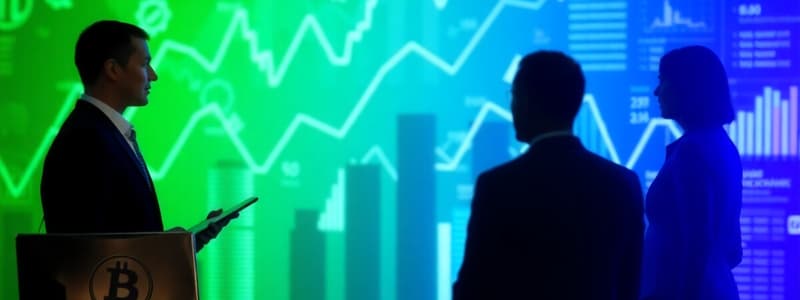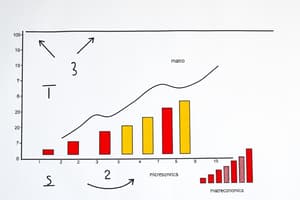Podcast
Questions and Answers
What is the primary focus of macroeconomists according to the content?
What is the primary focus of macroeconomists according to the content?
- To study the decisions of individual economic agents.
- To promote social benefits solely through taxation.
- To modify the aggregate effects of microeconomic decisions. (correct)
- To analyze historical economic philosophies.
Which area is mentioned as something society may pursue unselfishly?
Which area is mentioned as something society may pursue unselfishly?
- Consumer goods
- International trade policies
- Artistic expressions
- Health (correct)
According to Adam Smith, what motivates economic agents in a market economy?
According to Adam Smith, what motivates economic agents in a market economy?
- Self-interest (correct)
- Desire for communal harmony
- Benevolence towards others
- Concern for societal needs
What was the title of Adam Smith's significant work?
What was the title of Adam Smith's significant work?
What significant concept does the quote from Adam Smith suggest regarding economic transactions?
What significant concept does the quote from Adam Smith suggest regarding economic transactions?
Who were the prominent thinkers of political economy before Adam Smith?
Who were the prominent thinkers of political economy before Adam Smith?
In what year was 'An Enquiry into the Nature and Cause of the Wealth of Nations' published?
In what year was 'An Enquiry into the Nature and Cause of the Wealth of Nations' published?
Which economic factors are macroeconomists interested in modifying?
Which economic factors are macroeconomists interested in modifying?
What primarily characterizes microeconomics in comparison to macroeconomics?
What primarily characterizes microeconomics in comparison to macroeconomics?
What role do economic agents play in microeconomics?
What role do economic agents play in microeconomics?
Which of the following best describes General Equilibrium in microeconomics?
Which of the following best describes General Equilibrium in microeconomics?
What does macroeconomics focus on?
What does macroeconomics focus on?
How did economists initially view the relationships between buyers and sellers?
How did economists initially view the relationships between buyers and sellers?
What happens when markets do not exist according to the findings of economists?
What happens when markets do not exist according to the findings of economists?
Which of the following correctly states why macroeconomic considerations became essential?
Which of the following correctly states why macroeconomic considerations became essential?
What did Adam Smith suggest about the behavior of buyers and sellers in microeconomic theory?
What did Adam Smith suggest about the behavior of buyers and sellers in microeconomic theory?
What does the representative good symbolize in macroeconomic analysis?
What does the representative good symbolize in macroeconomic analysis?
Why is a single imaginary commodity used in macroeconomic analysis?
Why is a single imaginary commodity used in macroeconomic analysis?
What is one reason for analyzing the interdependence between agricultural and industrial sectors?
What is one reason for analyzing the interdependence between agricultural and industrial sectors?
What happens to the attributes like prices and wage rates when viewed in the context of individual commodities?
What happens to the attributes like prices and wage rates when viewed in the context of individual commodities?
Why might using a representative good be misleading in economic analysis?
Why might using a representative good be misleading in economic analysis?
During periods of inflation, how do the movements of economic variables across individual commodities typically behave?
During periods of inflation, how do the movements of economic variables across individual commodities typically behave?
What can be said about the employment levels when production levels are declining?
What can be said about the employment levels when production levels are declining?
What are the three general kinds of commodities that can be regarded as representative of an economy?
What are the three general kinds of commodities that can be regarded as representative of an economy?
How does macroeconomics differ from microeconomics?
How does macroeconomics differ from microeconomics?
What is a potential reason for departing from the simplification of using a single commodity?
What is a potential reason for departing from the simplification of using a single commodity?
What is typically observed during times when prices are rising quickly?
What is typically observed during times when prices are rising quickly?
Which of the following best describes the role of labor in macroeconomics versus microeconomics?
Which of the following best describes the role of labor in macroeconomics versus microeconomics?
What effect does simplifying to a representative good have on macroeconomic analysis?
What effect does simplifying to a representative good have on macroeconomic analysis?
What can be a consequence of treating a single category of labor as representative of all?
What can be a consequence of treating a single category of labor as representative of all?
Which factor is important in determining the output levels of different types of goods?
Which factor is important in determining the output levels of different types of goods?
What is a vital distinct characteristic that might be overlooked when categorizing goods?
What is a vital distinct characteristic that might be overlooked when categorizing goods?
What defines a capitalist economy?
What defines a capitalist economy?
What is the primary motive for an entrepreneur in a capitalist economy?
What is the primary motive for an entrepreneur in a capitalist economy?
In many underdeveloped countries, what is a common characteristic of production?
In many underdeveloped countries, what is a common characteristic of production?
What do we call the labour that is sold and purchased in exchange for wages?
What do we call the labour that is sold and purchased in exchange for wages?
Why may an entrepreneur face risks in a capitalist economy?
Why may an entrepreneur face risks in a capitalist economy?
Which of the following is NOT a characteristic of capitalist countries?
Which of the following is NOT a characteristic of capitalist countries?
What does the term 'firms' refer to in the context of capitalist economies?
What does the term 'firms' refer to in the context of capitalist economies?
In a capitalist economy, how do factors of production earn income?
In a capitalist economy, how do factors of production earn income?
What was a significant shift in the study of economics with the emergence of macroeconomics?
What was a significant shift in the study of economics with the emergence of macroeconomics?
In a capitalist economy, which role is primarily associated with entrepreneurs?
In a capitalist economy, which role is primarily associated with entrepreneurs?
Which of the following is NOT classified as a factor of production in the capitalist economy?
Which of the following is NOT classified as a factor of production in the capitalist economy?
What term is used to describe the money earned by entrepreneurs after paying for rent, interest, and wages?
What term is used to describe the money earned by entrepreneurs after paying for rent, interest, and wages?
What is the primary purpose of profit for entrepreneurs in production?
What is the primary purpose of profit for entrepreneurs in production?
Which of the following statements best describes investment expenditure in a capitalist economy?
Which of the following statements best describes investment expenditure in a capitalist economy?
In relation to production, which of the following is considered a fixed natural resource?
In relation to production, which of the following is considered a fixed natural resource?
Which statement best describes the relationship between revenue and costs in a capitalist enterprise?
Which statement best describes the relationship between revenue and costs in a capitalist enterprise?
Flashcards
Representative Good
Representative Good
A hypothetical good that represents the overall production and price level of an economy, simplifying analysis by aggregating all goods and services into one.
Aggregate Production
Aggregate Production
The total output of goods and services produced in an economy over a specific period, often measured as Gross Domestic Product (GDP).
General Price Level
General Price Level
The general level of prices for goods and services in an economy. It reflects the average change in prices for a basket of goods.
Inflation
Inflation
Signup and view all the flashcards
Depression
Depression
Signup and view all the flashcards
Macroeconomics
Macroeconomics
Signup and view all the flashcards
Simplification
Simplification
Signup and view all the flashcards
Distinct Sectors
Distinct Sectors
Signup and view all the flashcards
Economic Agents
Economic Agents
Signup and view all the flashcards
Equilibrium of Demand and Supply
Equilibrium of Demand and Supply
Signup and view all the flashcards
General Equilibrium
General Equilibrium
Signup and view all the flashcards
Invisible Hand
Invisible Hand
Signup and view all the flashcards
Consumer Choice
Consumer Choice
Signup and view all the flashcards
Profit Maximization
Profit Maximization
Signup and view all the flashcards
What is Macroeconomics?
What is Macroeconomics?
Signup and view all the flashcards
What is Microeconomic Decision-Making?
What is Microeconomic Decision-Making?
Signup and view all the flashcards
When does Macroeconomics Play a Role?
When does Macroeconomics Play a Role?
Signup and view all the flashcards
Who is Adam Smith?
Who is Adam Smith?
Signup and view all the flashcards
What are Macroeconomic Policies?
What are Macroeconomic Policies?
Signup and view all the flashcards
What is Microeconomics?
What is Microeconomics?
Signup and view all the flashcards
What were the Physiocrats?
What were the Physiocrats?
Signup and view all the flashcards
What is Inflation?
What is Inflation?
Signup and view all the flashcards
Interdependence of Economic Sectors
Interdependence of Economic Sectors
Signup and view all the flashcards
Limitations of Representative Goods
Limitations of Representative Goods
Signup and view all the flashcards
Heterogeneous Goods
Heterogeneous Goods
Signup and view all the flashcards
Macroeconomic Analysis
Macroeconomic Analysis
Signup and view all the flashcards
Microeconomics Focus
Microeconomics Focus
Signup and view all the flashcards
Macroeconomic Focus
Macroeconomic Focus
Signup and view all the flashcards
Link between Micro and Macro
Link between Micro and Macro
Signup and view all the flashcards
Sectoral Analysis
Sectoral Analysis
Signup and view all the flashcards
Capitalist Economy
Capitalist Economy
Signup and view all the flashcards
Means of Production
Means of Production
Signup and view all the flashcards
Wage Labor
Wage Labor
Signup and view all the flashcards
Wage Rate
Wage Rate
Signup and view all the flashcards
Entrepreneur
Entrepreneur
Signup and view all the flashcards
Profit
Profit
Signup and view all the flashcards
Firms
Firms
Signup and view all the flashcards
Risk and Uncertainty
Risk and Uncertainty
Signup and view all the flashcards
What are Capitalist Enterprises?
What are Capitalist Enterprises?
Signup and view all the flashcards
Who are Entrepreneurs?
Who are Entrepreneurs?
Signup and view all the flashcards
What are the Factors of Production?
What are the Factors of Production?
Signup and view all the flashcards
What is Revenue?
What is Revenue?
Signup and view all the flashcards
What are the Payments to Factors of Production?
What are the Payments to Factors of Production?
Signup and view all the flashcards
What is Investment Expenditure?
What is Investment Expenditure?
Signup and view all the flashcards
What is Profit?
What is Profit?
Signup and view all the flashcards
Study Notes
Introduction to Macroeconomics
- Macroeconomics differs from microeconomics by focusing on the overall economy, rather than individual markets
- Macroeconomics examines broad economic questions like price trends, employment levels, and economic health
- Key questions in macroeconomics include: will prices rise or fall? Will overall employment increase or decrease? What steps can improve the economy?
- The economy functions as a whole, with components generally moving together. For example, output, employment, and prices tend to move in tandem.
- Macroeconomic analysis simplifies by focusing on a representative good, but specific commodities often have different conditions.
Economic Agents
- Economic agents are individuals or institutions that make economic decisions (consumers, producers, governments, banks)
- Macroeconomics examines the aggregate effects of economic actions, considering factors like taxation, money supply, interest rates, etc.
Emergence of Macroeconomics
- Macroeconomics emerged as a distinct field after the 1929 Great Depression, which highlighted the interdependence of sectors and long-lasting unemployment.
- John Maynard Keynes' work, The General Theory of Employment, Interest and Money (1936), was influential in developing macroeconomics.
- Classical economics viewed the economy as self-regulating, assuming full employment.
The Context of Macroeconomics
- The study often focuses on capitalist economies, with production driven by entrepreneurs, labor, land, and capital.
- Revenue, wages, interest, and profits in the economy determine the income distribution
- Macroeconomic policies are implemented by the state and other institutions, aiming to improve various economic factors.
- Households, firms and governments are major sector players.
The External Sector
- International trade influences a country's economy.
- Countries import and export goods and services
- Capital flows between countries affect economic well-being.
Studying That Suits You
Use AI to generate personalized quizzes and flashcards to suit your learning preferences.




